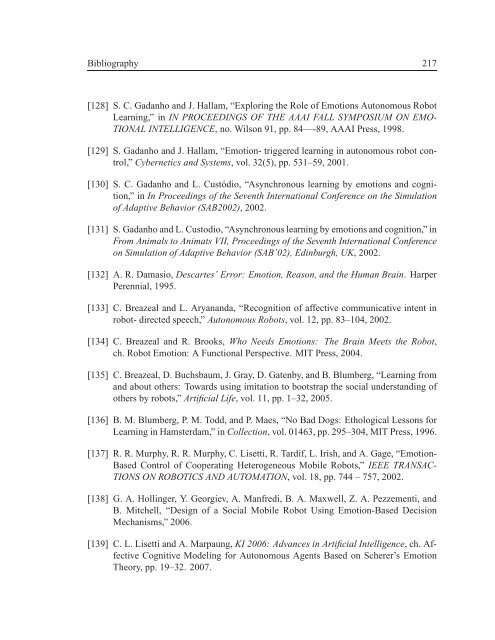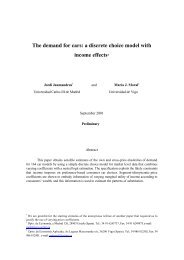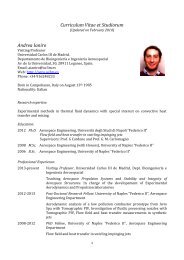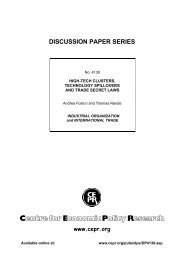216 Bibliography[115] B. Graf, U. Reiser, M. Hägele, K. Mauz, and P. Klein, “Robotic Home AssistantCare-O-bot ® 3 - Product Vision and Innovation Platform,” Components, pp. 312–320, 2008.[116] K. Ogawa, S. Nishio, K. Koda, K. Taura, T. Minato, C. T. Ishii, and H. Ishiguro,“Telenoid: Tele-presence android for communication,” in ACM SIGGRAPH 2011Emerging Technologies on - SIGGRAPH ’11, (New York, New York, USA), pp. 1–1, ACM Press, Aug. 2011.[117] V. RED’KOa and A. KOVAL, “Evolutionary Approach to Investigations of CognitiveSystems,” bicasociety.org, 2011.[118] J. Hirth, N. Schmitz, and K. Berns, “Towards Social Robots: Designing an Emotion-Based Architecture,” International Journal of Social <strong>Robotics</strong>, 2011.[119] A. Neto and F. da Silva, “A Computer Architecture for Intelligent Agents with Personalityand Emotions,” Human-Computer Interaction: The Agency Perspective,vol. 396, pp. 263—-285, 2012.[120] A. Matsuda, H. Misawa, and K. Horio, “Decision making based on reinforcementlearning and emotion learning for social behavior,” 2011.[121] J. D. Velásquez and P. Maes, “Cathexis: a computational mo<strong>de</strong>l of emotions,” inProceedings of the first international conference on Autonomous agents - AGENTS’97, (New York, New York, USA), pp. 518–519, ACM Press, Feb. 1997.[122] J. D. Velásquez, M. Fujita, and H. Kitano, “An Open Architecture for Emotion andBehavior Control of Autonomous Agents,” in Proceedings of the second internationalconference on Autonomous agents, pp. 473–474, ACM, 1998.[123] J. D. Velásquez, “Mo<strong>de</strong>ling Emotions and Other Motivations in Synthetic Agents,”Artificial Intelligence, pp. 10–15, 1997.[124] L. Cañamero, “Mo<strong>de</strong>ling motivations and emotions as a basis for intelligent behavior,”in First International Symposium on Autonomous Agents (Agents’97), 148-155.New York, NY: The ACM Press., 1997.[125] O. Avila-García and L. Cañamero, “Comparing a Voting-Based Policy with Winner-Takes-All to Perform Action Selection in Motivational Agents,” pp. 855–864, Nov.2002.[126] D. Cañamero, “Designing Emotions for Activity Selection,” 2000.[127] L. Cañamero, “Emotion un<strong>de</strong>rstanding from the perspective of autonomous robotsresearch,” Neural Networks, vol. 18, pp. 445–455, 2005.
Bibliography 217[128] S. C. Gadanho and J. Hallam, “Exploring the Role of Emotions Autonomous RobotLearning,” in IN PROCEEDINGS OF THE AAAI FALL SYMPOSIUM ON EMO-TIONAL INTELLIGENCE, no. Wilson 91, pp. 84—-89, AAAI Press, 1998.[129] S. Gadanho and J. Hallam, “Emotion- triggered learning in autonomous robot control,”Cybernetics and Systems, vol. 32(5), pp. 531–59, 2001.[130] S. C. Gadanho and L. Custódio, “Asynchronous learning by emotions and cognition,”in In Proceedings of the Seventh International Conference on the Simulationof Adaptive Behavior (SAB2002), 2002.[131] S. Gadanho and L. Custodio, “Asynchronous learning by emotions and cognition,” inFrom Animals to Animats VII, Proceedings of the Seventh International Conferenceon Simulation of Adaptive Behavior (SAB’02), Edinburgh, UK, 2002.[132] A. R. Damasio, Descartes’ Error: Emotion, Reason, and the Human Brain. HarperPerennial, 1995.[133] C. Breazeal and L. Aryananda, “Recognition of affective communicative intent inrobot- directed speech,” Autonomous Robots, vol. 12, pp. 83–104, 2002.[134] C. Breazeal and R. Brooks, Who Needs Emotions: The Brain Meets the Robot,ch. Robot Emotion: A Functional Perspective. MIT Press, 2004.[135] C. Breazeal, D. Buchsbaum, J. Gray, D. Gatenby, and B. Blumberg, “Learning fromand about others: Towards using imitation to bootstrap the social un<strong>de</strong>rstanding ofothers by robots,” Artificial Life, vol. 11, pp. 1–32, 2005.[136] B. M. Blumberg, P. M. Todd, and P. Maes, “No Bad Dogs: Ethological Lessons forLearning in Hamsterdam,” in Collection, vol. 01463, pp. 295–304, MIT Press, 1996.[137] R. R. Murphy, R. R. Murphy, C. Lisetti, R. Tardif, L. Irish, and A. Gage, “Emotion-Based Control of Cooperating Heterogeneous Mobile Robots,” IEEE TRANSAC-TIONS ON ROBOTICS AND AUTOMATION, vol. 18, pp. 744 – 757, 2002.[138] G. A. Hollinger, Y. Georgiev, A. Manfredi, B. A. Maxwell, Z. A. Pezzementi, andB. Mitchell, “Design of a Social Mobile Robot Using Emotion-Based DecisionMechanisms,” 2006.[139] C. L. Lisetti and A. Marpaung, KI 2006: Advances in Artificial Intelligence, ch. AffectiveCognitive Mo<strong>de</strong>ling for Autonomous Agents Based on Scherer’s EmotionTheory, pp. 19–32. 2007.
- Page 1:
TESIS DOCTORALBIO-INSPIRED DECISION
- Page 7 and 8:
AgradecimientosSon muchas las veces
- Page 9 and 10:
AbstractRobotics is an emergent fie
- Page 11 and 12:
ResumenLa robótica es un área eme
- Page 13 and 14:
ContentsAgradecimientosAbstractResu
- Page 15 and 16:
5 The social robot Maggie and its d
- Page 18 and 19:
9.4 Harm/interactions with Alvaro d
- Page 20 and 21:
3.10 An overview of the net of syst
- Page 23:
List of Algorithms6.1 Object Q-Lear
- Page 26 and 27:
xxii
- Page 28 and 29:
2 Chapter 1. IntroductionFigure 1.1
- Page 30 and 31:
4 Chapter 1. Introductionautonomous
- Page 32 and 33:
6 Chapter 1. IntroductionAs in othe
- Page 34 and 35:
8 Chapter 1. Introductiondesired ou
- Page 36 and 37:
10 Chapter 1. Introduction1.4 Overv
- Page 38 and 39:
12 Chapter 1. Introduction
- Page 40 and 41:
14 Chapter 2. Biological foundation
- Page 42 and 43:
16 Chapter 2. Biological foundation
- Page 44 and 45:
18 Chapter 2. Biological foundation
- Page 46 and 47:
20 Chapter 2. Biological foundation
- Page 48 and 49:
22 Chapter 2. Biological foundation
- Page 50 and 51:
24 Chapter 2. Biological foundation
- Page 52 and 53:
26 Chapter 2. Biological foundation
- Page 54 and 55:
28 Chapter 2. Biological foundation
- Page 56 and 57:
30 Chapter 2. Biological foundation
- Page 58 and 59:
32 Chapter 2. Biological foundation
- Page 60 and 61:
34 Chapter 2. Biological foundation
- Page 62 and 63:
36 Chapter 2. Biological foundation
- Page 64 and 65:
38 Chapter 3. State of the Artand b
- Page 66 and 67:
40 Chapter 3. State of the Art(a) R
- Page 68 and 69:
42 Chapter 3. State of the Artpatie
- Page 70 and 71:
44 Chapter 3. State of the Art(a) i
- Page 72 and 73:
46 Chapter 3. State of the Artrange
- Page 74 and 75:
48 Chapter 3. State of the Artwell
- Page 76 and 77:
50 Chapter 3. State of the Artthe a
- Page 78 and 79:
52 Chapter 3. State of the ArtThe e
- Page 80 and 81:
54 Chapter 3. State of the Arttask.
- Page 82 and 83:
56 Chapter 3. State of the Artthe r
- Page 84 and 85:
58 Chapter 3. State of the Artit is
- Page 86 and 87:
60 Chapter 3. State of the Artthe r
- Page 88 and 89:
62 Chapter 3. State of the Artnon-l
- Page 90 and 91:
64 Chapter 3. State of the ArtTAME
- Page 92 and 93:
66 Chapter 3. State of the ArtMinsk
- Page 94 and 95:
68 Chapter 3. State of the Art
- Page 96 and 97:
70 Chapter 4. The Decision Making S
- Page 98 and 99:
72 Chapter 4. The Decision Making S
- Page 100 and 101:
74 Chapter 4. The Decision Making S
- Page 102 and 103:
76 Chapter 4. The Decision Making S
- Page 104 and 105:
78 Chapter 4. The Decision Making S
- Page 106 and 107:
80 Chapter 4. The Decision Making S
- Page 108 and 109:
82 Chapter 4. The Decision Making S
- Page 110 and 111:
84 Chapter 4. The Decision Making S
- Page 112 and 113:
86 Chapter 4. The Decision Making S
- Page 114 and 115:
88 Chapter 5. The social robot Magg
- Page 116 and 117:
90 Chapter 5. The social robot Magg
- Page 118 and 119:
92 Chapter 5. The social robot Magg
- Page 120 and 121:
94 Chapter 5. The social robot Magg
- Page 122 and 123:
96 Chapter 5. The social robot Magg
- Page 124 and 125:
98 Chapter 5. The social robot Magg
- Page 126 and 127:
100 Chapter 5. The social robot Mag
- Page 128 and 129:
102 Chapter 5. The social robot Mag
- Page 130 and 131:
104 Chapter 5. The social robot Mag
- Page 132 and 133:
106 Chapter 5. The social robot Mag
- Page 134 and 135:
108 Chapter 5. The social robot Mag
- Page 136 and 137:
110 Chapter 6. Learning to make dec
- Page 138 and 139:
112 Chapter 6. Learning to make dec
- Page 140 and 141:
114 Chapter 6. Learning to make dec
- Page 142 and 143:
116 Chapter 6. Learning to make dec
- Page 144 and 145:
118 Chapter 6. Learning to make dec
- Page 146 and 147:
120 Chapter 6. Learning to make dec
- Page 148 and 149:
122 Chapter 6. Learning to make dec
- Page 150 and 151:
124 Chapter 6. Learning to make dec
- Page 152 and 153:
126 Chapter 6. Learning to make dec
- Page 154 and 155:
128 Chapter 7. Implementing the dec
- Page 156 and 157:
130 Chapter 7. Implementing the dec
- Page 158 and 159:
132 Chapter 7. Implementing the dec
- Page 160 and 161:
134 Chapter 7. Implementing the dec
- Page 162 and 163:
136 Chapter 7. Implementing the dec
- Page 164 and 165:
138 Chapter 7. Implementing the dec
- Page 166 and 167:
140 Chapter 7. Implementing the dec
- Page 168 and 169:
142 Chapter 7. Implementing the dec
- Page 170 and 171:
144 Chapter 7. Implementing the dec
- Page 172 and 173:
146 Chapter 7. Implementing the dec
- Page 174 and 175:
148 Chapter 7. Implementing the dec
- Page 176 and 177:
150 Chapter 7. Implementing the dec
- Page 178 and 179:
152 Chapter 7. Implementing the dec
- Page 180 and 181:
154 Chapter 7. Implementing the dec
- Page 182 and 183:
156 Chapter 7. Implementing the dec
- Page 184 and 185:
158 Chapter 7. Implementing the dec
- Page 186 and 187:
160 Chapter 7. Implementing the dec
- Page 188 and 189:
162 Chapter 7. Implementing the dec
- Page 190 and 191:
164 Chapter 7. Implementing the dec
- Page 192 and 193: 166 Chapter 8. Testing the experime
- Page 194 and 195: 168 Chapter 8. Testing the experime
- Page 196 and 197: 170 Chapter 8. Testing the experime
- Page 198 and 199: 172 Chapter 8. Testing the experime
- Page 200 and 201: 174 Chapter 8. Testing the experime
- Page 202 and 203: 176 Chapter 8. Testing the experime
- Page 204 and 205: 178 Chapter 9. Experimental Results
- Page 206 and 207: 180 Chapter 9. Experimental Results
- Page 208 and 209: 182 Chapter 9. Experimental Results
- Page 210 and 211: 184 Chapter 9. Experimental Results
- Page 212 and 213: 186 Chapter 9. Experimental Results
- Page 214 and 215: 188 Chapter 9. Experimental Results
- Page 216 and 217: 190 Chapter 9. Experimental Results
- Page 218 and 219: 192 Chapter 9. Experimental Results
- Page 220 and 221: 194 Chapter 9. Experimental Results
- Page 222 and 223: 196 Chapter 9. Experimental Results
- Page 224 and 225: 198 Chapter 10. Conclusions and Fut
- Page 226 and 227: 200 Chapter 10. Conclusions and Fut
- Page 228 and 229: 202 Chapter 10. Conclusions and Fut
- Page 230 and 231: 204 Chapter 10. Conclusions and Fut
- Page 232 and 233: 206 Chapter 10. Conclusions and Fut
- Page 234 and 235: 208 Bibliography[8] M. A. Martínez
- Page 236 and 237: 210 Bibliography[35] B. Hardy-Vall
- Page 238 and 239: 212 Bibliography[63] J. LeDoux, “
- Page 240 and 241: 214 Bibliography[90] C. Bartneck an
- Page 244 and 245: 218 Bibliography[140] W. P. Lee, J.
- Page 246 and 247: 220 Bibliography[166] C. Isbell, C.
- Page 248 and 249: 222 Bibliography[190] M. A. Salichs






